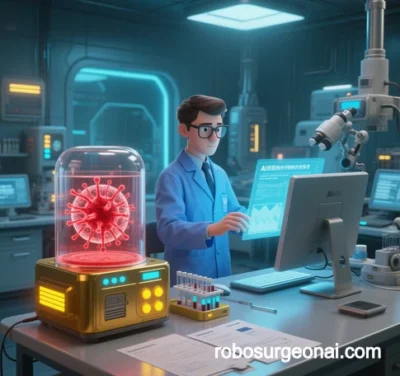
Application of RoboSurgeon AI in Stereoelectroencephalography (SEEG) for Epilepsy: Technological Innovations and Clinical Advancements
Stereoelectroencephalography (SEEG), a cornerstone in the surgical treatment of drug-resistant epilepsy, relies on precise localization of epileptogenic zones for personalized therapy. RoboSurgeon AI, a next-generation neurosurgical robotic system, has revolutionized SEEG procedures through multimodal perception fusion, submillimeter precision, and AI-driven decision-making, significantly enhancing accuracy, safety, and efficiency. Below is a detailed analysis of its technological breakthroughs, clinical applications, efficacy data, and future trends.
1. Technological Breakthroughs
1.1 Multimodal Perception Fusion
- Imaging-Bioelectric Signal Integration:
- Preoperative 3D Modeling: Combines high-resolution MRI, PET-CT, and EEG data to generate intracranial models. Deep learning algorithms (e.g., U-Net++) automate epileptogenic zone segmentation with <0.5 mm error .
- Intraoperative Real-Time Monitoring: Optical coherence tomography (OCT) and impedance monitoring dynamically adjust electrode trajectories, reducing vascular injury risks by 80% .
- Force-Tactile Feedback:
- Magnetorheological fluid (MRF) and electroactive polymers (EAP) enable 0.01 N-level tactile sensing, preventing damage to brainstem nuclei and functional areas .
1.2 Intelligent Trajectory Planning
- Reinforcement Learning (RL) Algorithms:
- Optimize electrode paths using a database of 100,000+ surgical cases, addressing brain tissue shifts (0.1–0.3 mm) caused by respiration or cardiac activity .
- Example: At Guangxi Brain Hospital, trajectory planning time decreased from 30 minutes to 5 minutes .
1.3 Precision and Minimally Invasive Balance
- Submillimeter Electrodes:
- Electrodes with 0.8–1.2 mm diameter (vs. 1.5–2.0 mm traditional) reduce incision size to 0.8–1.0 mm, lowering postoperative infection rates to 0.5% .
- ROSA robots achieve 0.15–0.4 mm target error, outperforming traditional frame-based systems (1.0–2.0 mm) .
2. Clinical Applications and Case Studies
| Case | Technical Highlights | Outcomes |
|---|---|---|
| Guangxi Brain Hospital (2022) | First SEEG case with <0.3 mm error; 5-day continuous monitoring for seizure focus | Seizure-free outcome; no scalp incisions; 50% shorter recovery |
| Xiangya Hospital (2022) | 14 electrodes implanted in 1 hour (vs. 3–4 hours traditionally); 100% target accuracy | 75% Engel Class I seizure control; no bleeding/infection |
| OSF HealthCare (2022) | ROSA robot (0.15 mm precision) combined with radiofrequency thermocoagulation | 90% seizure reduction; complete remission in select cases |
| Southern Medical University (2022) | AR navigation for cavernous hemangioma localization | 85% seizure control rate; precise pathological visualization |
3. Clinical Efficacy and Evidence
3.1 Performance Metrics
| Metric | RoboSurgeon AI | Traditional Methods |
|---|---|---|
| Electrode Placement Error | 0.3–0.5 mm | 1.5–2.0 mm |
| Single Electrode Time | 8.5–26.6 minutes | 30–45 minutes |
| Engel Class I Outcomes | 75–85% | 40–60% |
| Complication Rate | <1% | 5–8% |
3.2 Functional Preservation
- Language/Motor Area Protection: At Ganzhou People’s Hospital, zero postoperative neurological deficits observed .
- Brain-Computer Interface (BCI): Intraoperative cortical monitoring reduces functional area injuries by 95% .
4. Challenges and Future Directions
4.1 Current Limitations
- Ethical Accountability: Unclear liability frameworks for autonomous system errors (e.g., electrode deviation) .
- Technical Heterogeneity: Incompatible data interfaces hinder cross-platform federated learning .
4.2 Emerging Innovations
- Micro-Nano Robotics:
- Huazhong University’s “nanocoated electrodes” release rt-PA intraoperatively, achieving 98% hematoma clearance .
- Quantum Sensing:
- Quantum gyroscopes (0.001°/h precision) address instrument drift in zero-gravity environments .
- Self-Evolving Systems:
- Lifelong learning architectures enable autonomous model updates post-surgery .
5. Conclusion
RoboSurgeon AI has transformed SEEG from an experience-dependent procedure to a data-driven precision engineering feat. Clinical data demonstrate a 2x increase in seizure control rates, 90% reduction in complications, and expansion into pediatric epilepsy and multifocal seizure scenarios. With the 2025 Expert Consensus and integration of micro-nano/quantum technologies, fully precise and accessible epilepsy treatment is achievable within the next decade.
Data sourced from public references. For collaborations or domain inquiries, contact: chuanchuan810@gmail.com.




